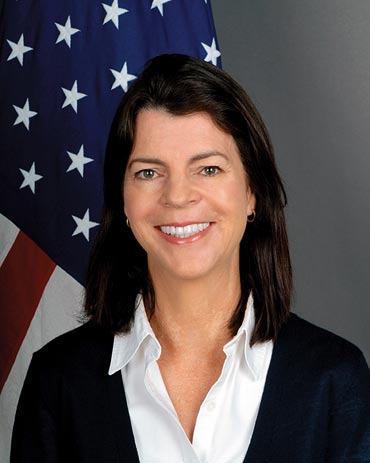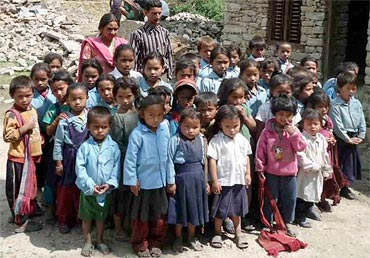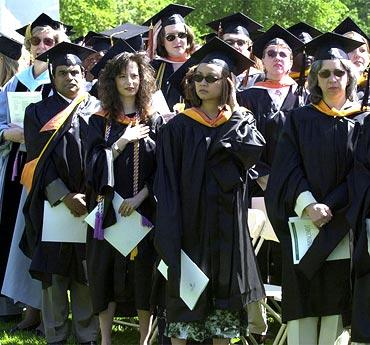Photographs: Careers360 Nitin Jindal
In India, to kick off a Community College initiative, Dr Molly Maguire Teas who was once a school teacher in a Nepalese village talks about her journey as a teacher, the US' vision in developing Indo-US education ties and the Community College initiative, spearheaded by Montgomery College, Maryland and funded by the US State Department to the tune of $ 195,000.
Is this your first visit to India?
I was a Peace Corps volunteer in Nepal in 1979. The United States Peace Corps is a Voluntary service abroad and you get a little government hand.
I was a Math teacher in a little village in Nepal. No blackboard, no chalk, no electricity, I carried my own water, I wore a lungi, no toilet, there were only 5 girls in Grade 6, Gurung village, up near Annapurna (mountain). That changed my life forever.
I was the first female teacher, of course, they had ever seen; first non-Brahmin teacher they had ever seen. I said to myself, I think that I can change more than a batch.
That's why I decided to change my life, I went to Harvard and got my doctorate in education policy. The rest of my life I have been trying to improve education. I worked here for the World Bank for years. I worked on District Primary Education Programme (DPEP), which is now Sarva Shiksha Abhiyaan
'I stayed there because of the people, I was so mad about them'
Image: School children from a village in NepalPhotographs: Rediff Archives
If you grow up in my small town in Wisconsin, where the only jobs available were working in the paper mill, it's a different environment.
Someone came to my school and showed pictures of Nepal, he had been on a trek there and I took to it., not knowing that the development part of it is what would change my life. I went because of the mountains, but that is not why I stayed there, I stayed there because of the people, I was so mad about them.
In a follow-up to the story about when I was a school teacher in 1979 in Nepal, there were 4-5 girls in 6th grade. No one had ever been to 7th or 8th or 9th standards. I went back 10 years later to do my dissertation, and I went back to my village, and one of my girls had become a teacher, a school teacher.
For me, to be working in a little school, with the little girls who have no opportunity, that's what it is all about really.
Tell us about the Community College projects.
I came to know that the Haryana State governor had reached out to Montgomery College four years back because they wanted to transform their polytechnic to the Community College model. So they visited Montgomery College using their own funds and Montgomery College visited them. But the economy took a downturn and the project stagnated.
When I came to learn that Haryana was very interested, I thought it was something we should support and revive. So, I called Montgomery College.
Now they are involving us with three different schools in India, not just the Haryana one, so we've revived this. What we've done is set up a series of exchanges, faculty administrator exchanges and also a symposium. This is just to kick off a larger effort.
'We would love more Americans to visit India'
Image: Obama adressing students of St Xavier's College in MumbaiPhotographs: Jim Young/Reuters
It has got two parts. One is responding to the interest of the Indians ie that what part of the American Community college model could be adapted for India; what makes sense here.
President Barack Obama is committed to creating a 21st century workforce and part of that is making sure that our students have the international mindset and global exposure.
And how can we do that? We can't do that by sitting by ourselves at Montgomery College. So while they are doing the exchanges through the relationships that they build with instructors and professors, they are learning about the country, so that they can talk to their students about India.
They'll be creating case studies and internationalising their curriculum. There are already a lot of Indian students in United States, who are the bulk, though we'd like to have more. We would love this to be a springboard for more Americans to visit India.
The way we think about it is that it is brain circulation. We think that supporting the improvement of education here is a win-win situation for everyone.
Can you elaborate?
In the olden days when the Indians came to the States they called it "brain drain" but it was a "brain gain" for us (smiles). In fact, some universities like the University of Michigan State figured out a way to lure Indians and Chinese to invest in Michigan businesses.
What is important to us is developing people exchanges and developing the understanding of a different culture. So we are hoping that fruitful personal relationships come out of this exchan#8805 these are the kinds of things that change peoples' lives. The current project is part of a larger effort to promote US-India education partnership.'We're eager to increase these relationships and partnerships'
Image: Picture for representation purposes onlyPhotographs: Mohammed Jaffer/SnapsIndia
The Fulbright Program has dramatically expanded. In 2007-08 there were only a 100 Fulbright students and scholars and now with Fulbright-Nehru, India would be becoming an equal partner, we have more than 250 Fulbright-Nehru grantees in the academic year 2010-11.
We are also funding 48 Indians this year to come to Community Colleges in United States, it is a part of the State Department programme.
The other thing we have is Education U.S. which is the advising body that the U.S. State Department supports. One of its centres is right here called United States India Education Foundation (USEFI) which informs Indians about the opportunities in United States.
Do you foresee any reduction in the number of Indians going to the US for education?
No, no!! Now for the first time the Chinese have surpassed the Indians in terms of the numbers. I believe there are 103,000 Indians this year and 120,000 Chinese.
What we say is we welcome Indians to come in more and more numbers. You must know that most of them come at the postgraduate level, and we are focusing on telling them to come for more undergraduate programmes.
However, fewer than 3,000 Americans study in India. That's a huge imbalance and we would like that to change. So we're looking at ways, whether it's studying in your programmes, whether it's internships, whether it's research, joint research projects, whether it's exchanges, we are very eager to explore avenues to increase these relationships and partnerships.





Comment
article